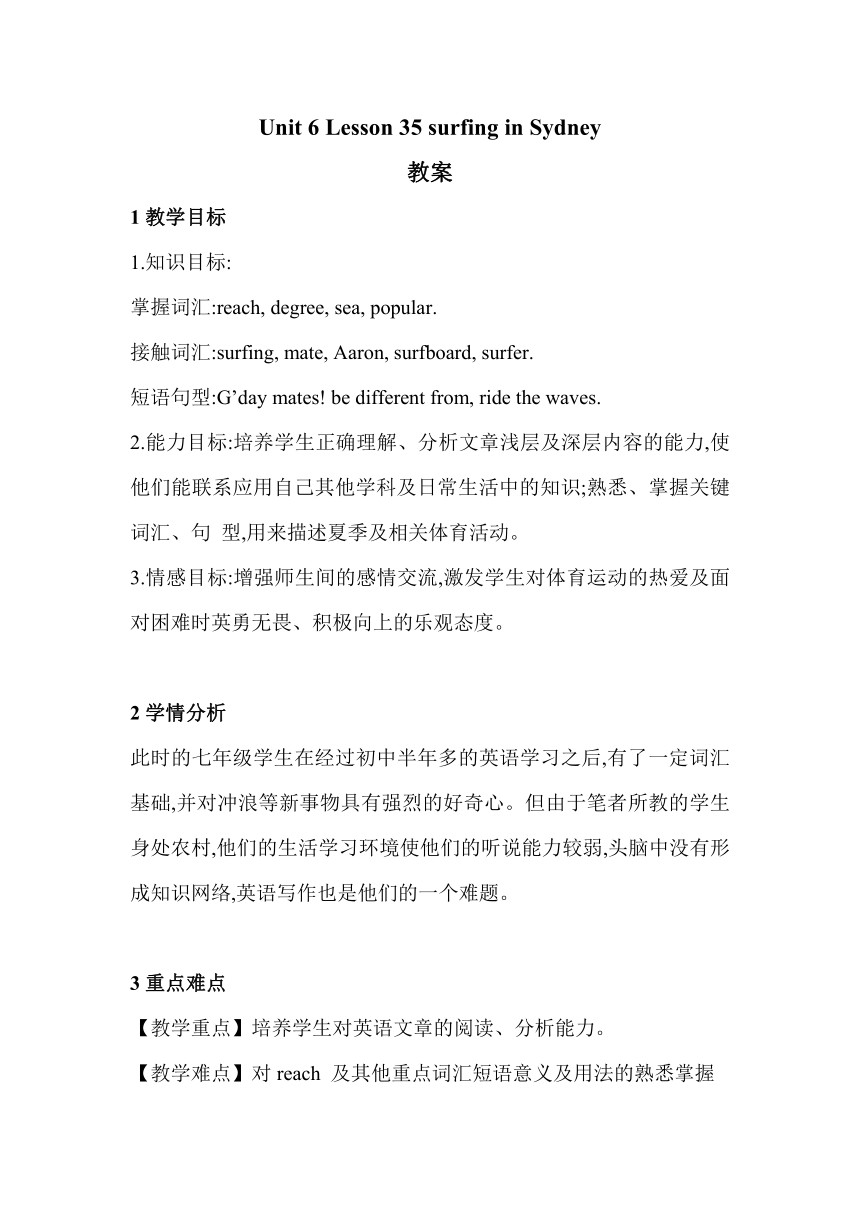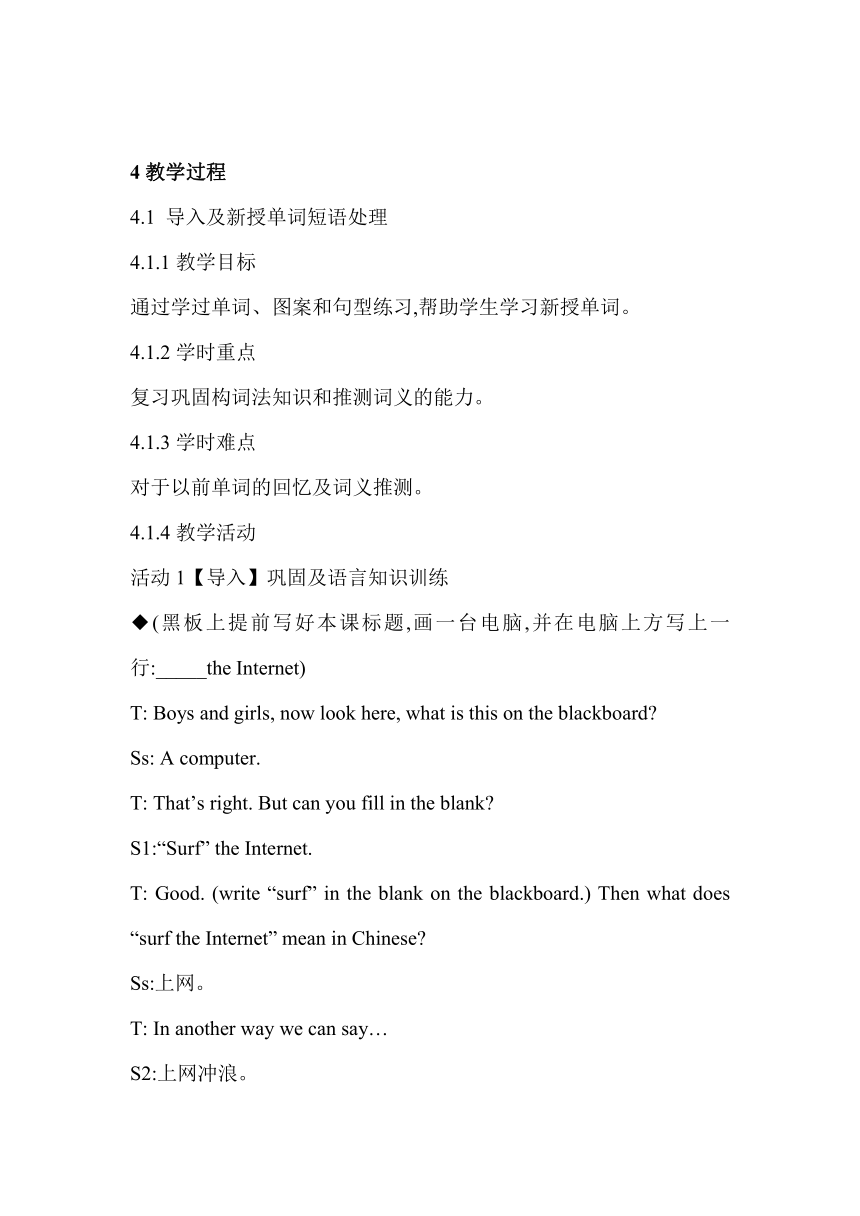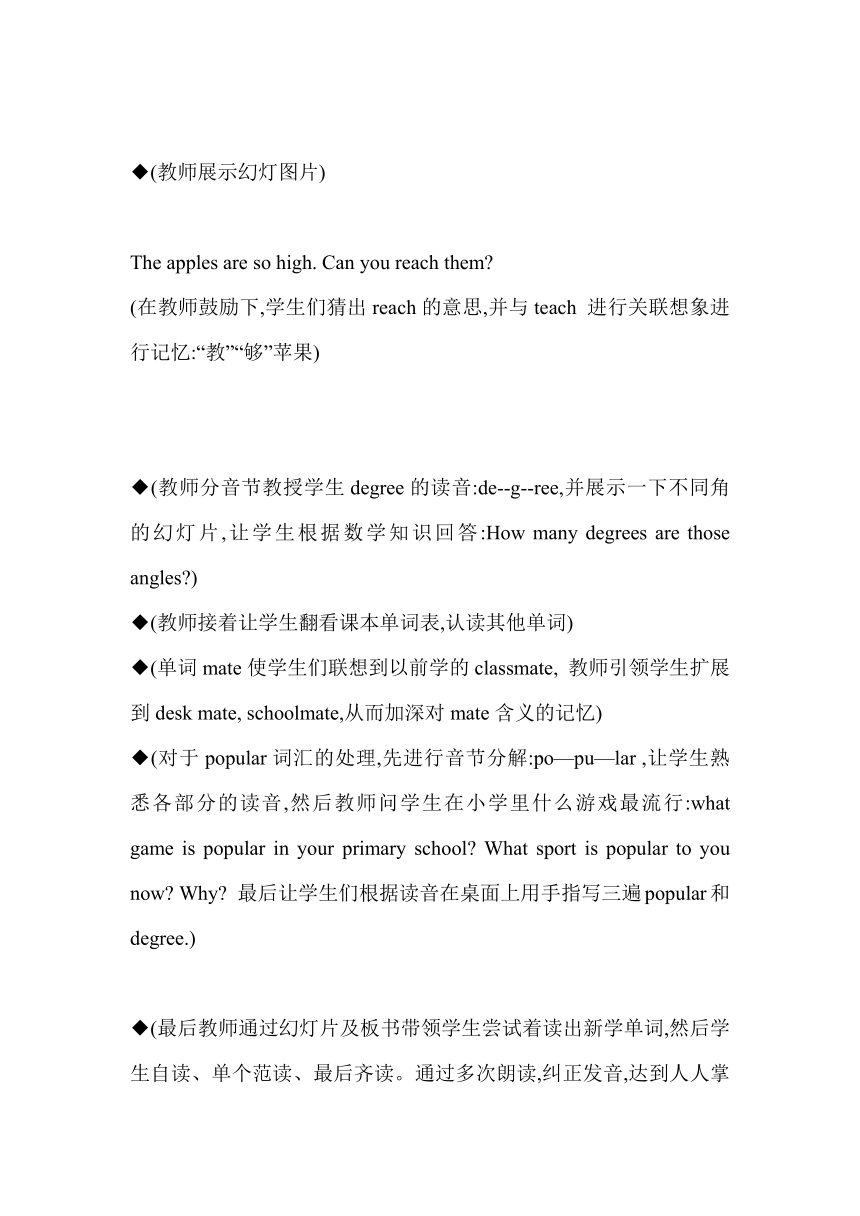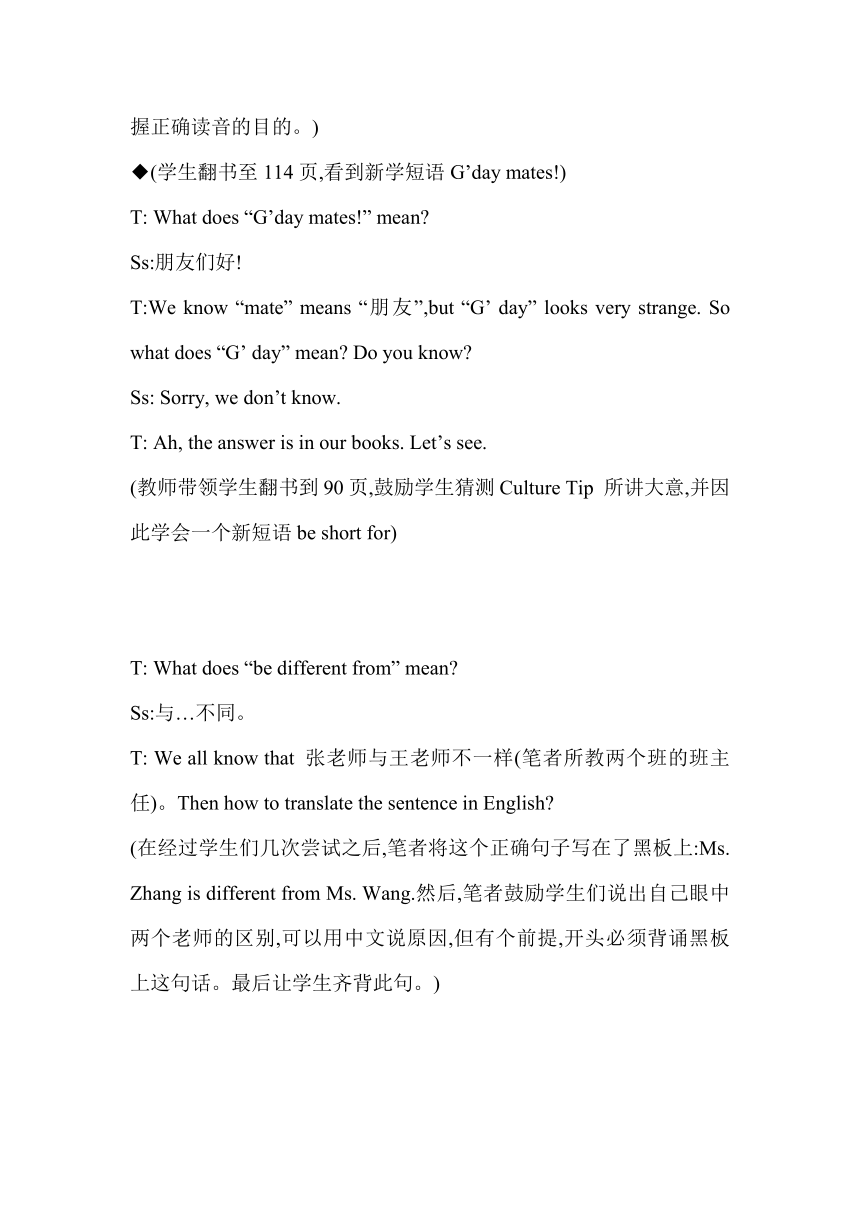Unit 6 Lesson 35 surfing in Sydney 教案
文档属性
| 名称 | Unit 6 Lesson 35 surfing in Sydney 教案 |  | |
| 格式 | zip | ||
| 文件大小 | 122.2KB | ||
| 资源类型 | 教案 | ||
| 版本资源 | 冀教版 | ||
| 科目 | 英语 | ||
| 更新时间 | 2017-03-03 22:17:03 | ||
图片预览





文档简介
Unit
6
Lesson
35
surfing
in
Sydney
教案
1教学目标
1.知识目标:
掌握词汇:reach,
degree,
sea,
popular.
接触词汇:surfing,
mate,
Aaron,
surfboard,
surfer.
短语句型:G’day
mates!
be
different
from,
ride
the
waves.
2.能力目标:培养学生正确理解、分析文章浅层及深层内容的能力,使他们能联系应用自己其他学科及日常生活中的知识;熟悉、掌握关键词汇、句
型,用来描述夏季及相关体育活动。
3.情感目标:增强师生间的感情交流,激发学生对体育运动的热爱及面对困难时英勇无畏、积极向上的乐观态度。
2学情分析
此时的七年级学生在经过初中半年多的英语学习之后,有了一定词汇基础,并对冲浪等新事物具有强烈的好奇心。但由于笔者所教的学生身处农村,他们的生活学习环境使他们的听说能力较弱,头脑中没有形成知识网络,英语写作也是他们的一个难题。
3重点难点
【教学重点】培养学生对英语文章的阅读、分析能力。
【教学难点】对reach
及其他重点词汇短语意义及用法的熟悉掌握
4教学过程
4.1
导入及新授单词短语处理
4.1.1教学目标
通过学过单词、图案和句型练习,帮助学生学习新授单词。
4.1.2学时重点
复习巩固构词法知识和推测词义的能力。
4.1.3学时难点
对于以前单词的回忆及词义推测。
4.1.4教学活动
活动1【导入】巩固及语言知识训练
◆(黑板上提前写好本课标题,画一台电脑,并在电脑上方写上一行:_____the
Internet)
T:
Boys
and
girls,
now
look
here,
what
is
this
on
the
blackboard
Ss:
A
computer.
T:
That’s
right.
But
can
you
fill
in
the
blank
S1:“Surf”
the
Internet.
T:
Good.
(write
“surf”
in
the
blank
on
the
blackboard.)
Then
what
does
“surf
the
Internet”
mean
in
Chinese
Ss:上网。
T:
In
another
way
we
can
say…
S2:上网冲浪。
T:
Good
memory.
So
what
does
“surf”
mean
in
Chinese
Ss:冲浪。
T:
That’s
more
exact!
Now
who
can
guess
the
meanings
of
the
following
words
Try
your
best!
(教师在黑板上书写:surf
surfing
Surfer
surf
board)
Ss:冲浪运动、冲浪者、冲浪板。
T:
Wonderful!
If
I
want
to
say:“让我们去冲浪吧!”In
English,
what
should
I
say
S3:Let’sgosurfing.
(教师用投影将本课课本上冲浪板的图片进行展示,并随机提问)
T:
Now
what
can
you
see
in
the
picture
Ss:
Many
surfboards.
T:
What
do
you
think
of
the
surf
boards
Ss:
different,
beautiful,
colorful,
lovely…
T:
The
surfboards
are
all
good-looking.
(教师又展示课本上冲浪者的照片)
T:
What
is
the
man
doing
Ss:
Surfing.
T:
So
we
can
say
he
is
a…
Ss:
Surfer.
T:
This
surfer
looks
very
strong
and
brave.
◆(教师展示幻灯图片)
The
apples
are
so
high.
Can
you
reach
them
(在教师鼓励下,学生们猜出reach的意思,并与teach
进行关联想象进行记忆:“教”“够”苹果)
◆(教师分音节教授学生degree的读音:de--g--ree,并展示一下不同角的幻灯片,让学生根据数学知识回答:How
many
degrees
are
those
angles )
◆(教师接着让学生翻看课本单词表,认读其他单词)
◆(单词mate使学生们联想到以前学的classmate,
教师引领学生扩展到desk
mate,
schoolmate,从而加深对mate含义的记忆)
◆(对于popular词汇的处理,先进行音节分解:po—pu—lar
,让学生熟悉各部分的读音,然后教师问学生在小学里什么游戏最流行:what
game
is
popular
in
your
primary
school
What
sport
is
popular
to
you
now
Why
最后让学生们根据读音在桌面上用手指写三遍popular和degree.)
◆(最后教师通过幻灯片及板书带领学生尝试着读出新学单词,然后学生自读、单个范读、最后齐读。通过多次朗读,纠正发音,达到人人掌握正确读音的目的。)
◆(学生翻书至114页,看到新学短语G’day
mates!)
T:
What
does
“G’day
mates!”
mean
Ss:朋友们好!
T:We
know
“mate”
means
“朋友”,but
“G’
day”
looks
very
strange.
So
what
does
“G’
day”
mean
Do
you
know
Ss:
Sorry,
we
don’t
know.
T:
Ah,
the
answer
is
in
our
books.
Let’s
see.
(教师带领学生翻书到90页,鼓励学生猜测Culture
Tip
所讲大意,并因此学会一个新短语be
short
for)
T:
What
does
“be
different
from”
mean
Ss:与…不同。
T:
We
all
know
that
张老师与王老师不一样(笔者所教两个班的班主任)。Then
how
to
translate
the
sentence
in
English
(在经过学生们几次尝试之后,笔者将这个正确句子写在了黑板上:Ms.
Zhang
is
different
from
Ms.
Wang.然后,笔者鼓励学生们说出自己眼中两个老师的区别,可以用中文说原因,但有个前提,开头必须背诵黑板上这句话。最后让学生齐背此句。)
活动2【讲授】课文学习
◆Paragraph
1
T:
The
title
of
the
passage
is
“Surfing
in
Sydney”.
A
boy
called
Aaron
lives
in
Sydney.
What
kind
of
boy
is
he
What
is
Sydney
like
in
Aaron’s
eyes
Now
we
will
listen
to
him.
(教师放第一自然段的课本录音)
(通过学生抢答,总结出段落要点,再次强调G’day
mates!,
beach,
reach,
degree的含义)
T:Now,
according
to
this
paragraph
do
you
like
Sydney
Why
(通过对悉尼天气、地理的对比,学生谈出自己的看法,同时又自然地应用到G’day
mates!,
beach,
reach,
degree这几个重点词汇和短语。)
(最后,齐读第一段,再次体会关键词句。)
[设计说明]
第一段短小而且简单,作为阅读内容对学生来说挑战性不大,因此改为听力,也可以增加学生听地道英语的机会。之后的讨论,可以让学生自然地运用关键词句,学以致用。
◆Paragraph
2
T:
What
does
Aaron
want
to
tell
us
next
Read
the
paragraph2
by
yourself.
(接下来教师让学生翻译全段,之后脱离课本跟读录音)
T;
Why
are
the
seasons
in
Sydney
so
different
from
the
seasons
in
China
(鼓励学生用地理知识来做答)
[设计说明]
第二段的难点在于月份,有学生可能回忆不清,因此采用翻译法。同时引导学生回忆以前讲的have
to和
感叹句等重点内容。
◆Paragraph
3
T:
Now
tell
me,
what
is
Aaron’s
favorite
season
Ss:
Summer.
T:
Yes,
but
what
does
he
like
to
do
in
summer
Can
you
guess
Ss:
Surfing.
T:
You
are
very
smart.
Then
read
the
following
parts,
and
tell
me
how
much
does
he
like
surfing
(学生自读课文)
S4:
He
likes
surfing
very
much.
T:
How
do
you
know
that
S4:
Because
he
wants
to
be
a
surfer
in
the
future.
T:
Good
job.
If
we
want
to
do
a
job
in
the
future,
we
must
love
it
very
much.
Can
you
find
any
other
reasons
S5:
Surfing
is
difficult,
but
good
exercise.
T:
Can
you
translate
it
S6:冲浪很难,但确实很好的锻炼。
T:
Well
done!
I
think
this
is
one
of
the
reasons
why
he
likes
surfing
so
much.
Can
you
find
more
reasons
Why
does
he
like
surfing
so
much
Ss:
It
is
very
popular.
(T:
Yes,
if
everyone
loves
surfing,
it
will
become
a
national
sport
and
no
doubt
Aaron
will
love
it,
too.)
Ss:
His
mother
and
father
like
it,
too.
(T:
how
do
you
know
that )
Ss:
They
often
come
and
watch
him
surf,
and
take
pictures
of
him.
[设计说明]
首先,教师用提问的方式引导学生对下面的学习内容进行预测,使学生形成阅读期待。对于这部分文章内容的处理,笔者找寻到了可以深入分析作者写作的两个角度:一是对冲浪的“love”,一个是陈述对冲浪运动热爱的“reasons”。这样,这部分文章条理就清楚了。
活动3【练习】读后练习
◆[教师将课后第二题扩展为幻灯片猜词抢答题,将答案逐个字母写出做提示]
例如:
幻灯片题目a
big
body
of
water
on
the
earth
提示答案:s----e-----a
A
word
to
describe
temperature
d---e---g---r---e---e
Get
to,
arrive
at
r---e---a---c----h
Be
liked
by
many
people
p----o---p---u---l---a—r
Another
way
to
call
a
friend
m---a---t---e
Sands
beside
the
sea
b---e---a---c---h
A
sport
liked
by
many
Australians
s---u---r---f---i---n---g
◆[让学生自己做课后第三题,然后对答案。](习题内容略)
[设计说明]
分别用游戏的方式和做题的方式帮助学生回忆本课重点单词及短语。有研究表明,尝试性回忆对学生的学习记忆非常重要,因此这项活动是必不可少的。
Language
points
[要求学生翻译下面三个句子,并指出所包含的重点结构]
朋友们好!
张老师与王老师不同。
我和我妹妹不一样。
我可以在冲浪板上冲浪。
[设计说明]
通过造句练习G’day
mates!
be
different
from,
ride
the
waves
三个重点结构,使学生会灵活运用be动词。最后一句的翻译,可以趁机拓展学生知识面,告诉学生这句并不啰嗦,因为冲浪有很多种工具,可以在冲浪板上运动,也可以在腹板、充气橡皮艇上进行。
[要求学生翻译、抄写各句,并注意其中‘reach’的不同含义]
Often,
the
temperature
reaches
40
degrees.
He
reached
Beijing
yesterday.
The
apples
are
so
high,
so
he
can’t
reach
them.
[设计说明]
曾有教师就语言点该不该教进行过讨论。笔者的看法是,在反复熟悉课文及重点结构的基础上,在理解应用的环节中讲解,更有针对性。
活动4【作业】作业布置
Step
4:
homework
◆抄写单词、课文、笔记
◆做同步练习册
◆作文:仿照课文,写一项自己在夏季喜欢的运动,并说明原因。
6
Lesson
35
surfing
in
Sydney
教案
1教学目标
1.知识目标:
掌握词汇:reach,
degree,
sea,
popular.
接触词汇:surfing,
mate,
Aaron,
surfboard,
surfer.
短语句型:G’day
mates!
be
different
from,
ride
the
waves.
2.能力目标:培养学生正确理解、分析文章浅层及深层内容的能力,使他们能联系应用自己其他学科及日常生活中的知识;熟悉、掌握关键词汇、句
型,用来描述夏季及相关体育活动。
3.情感目标:增强师生间的感情交流,激发学生对体育运动的热爱及面对困难时英勇无畏、积极向上的乐观态度。
2学情分析
此时的七年级学生在经过初中半年多的英语学习之后,有了一定词汇基础,并对冲浪等新事物具有强烈的好奇心。但由于笔者所教的学生身处农村,他们的生活学习环境使他们的听说能力较弱,头脑中没有形成知识网络,英语写作也是他们的一个难题。
3重点难点
【教学重点】培养学生对英语文章的阅读、分析能力。
【教学难点】对reach
及其他重点词汇短语意义及用法的熟悉掌握
4教学过程
4.1
导入及新授单词短语处理
4.1.1教学目标
通过学过单词、图案和句型练习,帮助学生学习新授单词。
4.1.2学时重点
复习巩固构词法知识和推测词义的能力。
4.1.3学时难点
对于以前单词的回忆及词义推测。
4.1.4教学活动
活动1【导入】巩固及语言知识训练
◆(黑板上提前写好本课标题,画一台电脑,并在电脑上方写上一行:_____the
Internet)
T:
Boys
and
girls,
now
look
here,
what
is
this
on
the
blackboard
Ss:
A
computer.
T:
That’s
right.
But
can
you
fill
in
the
blank
S1:“Surf”
the
Internet.
T:
Good.
(write
“surf”
in
the
blank
on
the
blackboard.)
Then
what
does
“surf
the
Internet”
mean
in
Chinese
Ss:上网。
T:
In
another
way
we
can
say…
S2:上网冲浪。
T:
Good
memory.
So
what
does
“surf”
mean
in
Chinese
Ss:冲浪。
T:
That’s
more
exact!
Now
who
can
guess
the
meanings
of
the
following
words
Try
your
best!
(教师在黑板上书写:surf
surfing
Surfer
surf
board)
Ss:冲浪运动、冲浪者、冲浪板。
T:
Wonderful!
If
I
want
to
say:“让我们去冲浪吧!”In
English,
what
should
I
say
S3:Let’sgosurfing.
(教师用投影将本课课本上冲浪板的图片进行展示,并随机提问)
T:
Now
what
can
you
see
in
the
picture
Ss:
Many
surfboards.
T:
What
do
you
think
of
the
surf
boards
Ss:
different,
beautiful,
colorful,
lovely…
T:
The
surfboards
are
all
good-looking.
(教师又展示课本上冲浪者的照片)
T:
What
is
the
man
doing
Ss:
Surfing.
T:
So
we
can
say
he
is
a…
Ss:
Surfer.
T:
This
surfer
looks
very
strong
and
brave.
◆(教师展示幻灯图片)
The
apples
are
so
high.
Can
you
reach
them
(在教师鼓励下,学生们猜出reach的意思,并与teach
进行关联想象进行记忆:“教”“够”苹果)
◆(教师分音节教授学生degree的读音:de--g--ree,并展示一下不同角的幻灯片,让学生根据数学知识回答:How
many
degrees
are
those
angles )
◆(教师接着让学生翻看课本单词表,认读其他单词)
◆(单词mate使学生们联想到以前学的classmate,
教师引领学生扩展到desk
mate,
schoolmate,从而加深对mate含义的记忆)
◆(对于popular词汇的处理,先进行音节分解:po—pu—lar
,让学生熟悉各部分的读音,然后教师问学生在小学里什么游戏最流行:what
game
is
popular
in
your
primary
school
What
sport
is
popular
to
you
now
Why
最后让学生们根据读音在桌面上用手指写三遍popular和degree.)
◆(最后教师通过幻灯片及板书带领学生尝试着读出新学单词,然后学生自读、单个范读、最后齐读。通过多次朗读,纠正发音,达到人人掌握正确读音的目的。)
◆(学生翻书至114页,看到新学短语G’day
mates!)
T:
What
does
“G’day
mates!”
mean
Ss:朋友们好!
T:We
know
“mate”
means
“朋友”,but
“G’
day”
looks
very
strange.
So
what
does
“G’
day”
mean
Do
you
know
Ss:
Sorry,
we
don’t
know.
T:
Ah,
the
answer
is
in
our
books.
Let’s
see.
(教师带领学生翻书到90页,鼓励学生猜测Culture
Tip
所讲大意,并因此学会一个新短语be
short
for)
T:
What
does
“be
different
from”
mean
Ss:与…不同。
T:
We
all
know
that
张老师与王老师不一样(笔者所教两个班的班主任)。Then
how
to
translate
the
sentence
in
English
(在经过学生们几次尝试之后,笔者将这个正确句子写在了黑板上:Ms.
Zhang
is
different
from
Ms.
Wang.然后,笔者鼓励学生们说出自己眼中两个老师的区别,可以用中文说原因,但有个前提,开头必须背诵黑板上这句话。最后让学生齐背此句。)
活动2【讲授】课文学习
◆Paragraph
1
T:
The
title
of
the
passage
is
“Surfing
in
Sydney”.
A
boy
called
Aaron
lives
in
Sydney.
What
kind
of
boy
is
he
What
is
Sydney
like
in
Aaron’s
eyes
Now
we
will
listen
to
him.
(教师放第一自然段的课本录音)
(通过学生抢答,总结出段落要点,再次强调G’day
mates!,
beach,
reach,
degree的含义)
T:Now,
according
to
this
paragraph
do
you
like
Sydney
Why
(通过对悉尼天气、地理的对比,学生谈出自己的看法,同时又自然地应用到G’day
mates!,
beach,
reach,
degree这几个重点词汇和短语。)
(最后,齐读第一段,再次体会关键词句。)
[设计说明]
第一段短小而且简单,作为阅读内容对学生来说挑战性不大,因此改为听力,也可以增加学生听地道英语的机会。之后的讨论,可以让学生自然地运用关键词句,学以致用。
◆Paragraph
2
T:
What
does
Aaron
want
to
tell
us
next
Read
the
paragraph2
by
yourself.
(接下来教师让学生翻译全段,之后脱离课本跟读录音)
T;
Why
are
the
seasons
in
Sydney
so
different
from
the
seasons
in
China
(鼓励学生用地理知识来做答)
[设计说明]
第二段的难点在于月份,有学生可能回忆不清,因此采用翻译法。同时引导学生回忆以前讲的have
to和
感叹句等重点内容。
◆Paragraph
3
T:
Now
tell
me,
what
is
Aaron’s
favorite
season
Ss:
Summer.
T:
Yes,
but
what
does
he
like
to
do
in
summer
Can
you
guess
Ss:
Surfing.
T:
You
are
very
smart.
Then
read
the
following
parts,
and
tell
me
how
much
does
he
like
surfing
(学生自读课文)
S4:
He
likes
surfing
very
much.
T:
How
do
you
know
that
S4:
Because
he
wants
to
be
a
surfer
in
the
future.
T:
Good
job.
If
we
want
to
do
a
job
in
the
future,
we
must
love
it
very
much.
Can
you
find
any
other
reasons
S5:
Surfing
is
difficult,
but
good
exercise.
T:
Can
you
translate
it
S6:冲浪很难,但确实很好的锻炼。
T:
Well
done!
I
think
this
is
one
of
the
reasons
why
he
likes
surfing
so
much.
Can
you
find
more
reasons
Why
does
he
like
surfing
so
much
Ss:
It
is
very
popular.
(T:
Yes,
if
everyone
loves
surfing,
it
will
become
a
national
sport
and
no
doubt
Aaron
will
love
it,
too.)
Ss:
His
mother
and
father
like
it,
too.
(T:
how
do
you
know
that )
Ss:
They
often
come
and
watch
him
surf,
and
take
pictures
of
him.
[设计说明]
首先,教师用提问的方式引导学生对下面的学习内容进行预测,使学生形成阅读期待。对于这部分文章内容的处理,笔者找寻到了可以深入分析作者写作的两个角度:一是对冲浪的“love”,一个是陈述对冲浪运动热爱的“reasons”。这样,这部分文章条理就清楚了。
活动3【练习】读后练习
◆[教师将课后第二题扩展为幻灯片猜词抢答题,将答案逐个字母写出做提示]
例如:
幻灯片题目a
big
body
of
water
on
the
earth
提示答案:s----e-----a
A
word
to
describe
temperature
d---e---g---r---e---e
Get
to,
arrive
at
r---e---a---c----h
Be
liked
by
many
people
p----o---p---u---l---a—r
Another
way
to
call
a
friend
m---a---t---e
Sands
beside
the
sea
b---e---a---c---h
A
sport
liked
by
many
Australians
s---u---r---f---i---n---g
◆[让学生自己做课后第三题,然后对答案。](习题内容略)
[设计说明]
分别用游戏的方式和做题的方式帮助学生回忆本课重点单词及短语。有研究表明,尝试性回忆对学生的学习记忆非常重要,因此这项活动是必不可少的。
Language
points
[要求学生翻译下面三个句子,并指出所包含的重点结构]
朋友们好!
张老师与王老师不同。
我和我妹妹不一样。
我可以在冲浪板上冲浪。
[设计说明]
通过造句练习G’day
mates!
be
different
from,
ride
the
waves
三个重点结构,使学生会灵活运用be动词。最后一句的翻译,可以趁机拓展学生知识面,告诉学生这句并不啰嗦,因为冲浪有很多种工具,可以在冲浪板上运动,也可以在腹板、充气橡皮艇上进行。
[要求学生翻译、抄写各句,并注意其中‘reach’的不同含义]
Often,
the
temperature
reaches
40
degrees.
He
reached
Beijing
yesterday.
The
apples
are
so
high,
so
he
can’t
reach
them.
[设计说明]
曾有教师就语言点该不该教进行过讨论。笔者的看法是,在反复熟悉课文及重点结构的基础上,在理解应用的环节中讲解,更有针对性。
活动4【作业】作业布置
Step
4:
homework
◆抄写单词、课文、笔记
◆做同步练习册
◆作文:仿照课文,写一项自己在夏季喜欢的运动,并说明原因。
同课章节目录
- Unit 1 A Trip to the Silk Road
- Lesson 1 A Trip to China
- Lesson 2 Meet You in Beijing
- Lesson 3 A Visit to Xi'an
- Lesson 4 A Visit to Lanzhou
- Lesson 5 Another Stop along the Silk Road
- Lesson 6 Jenny's Diary
- Unit 2 It's Show Time!
- Lesson 7 What's Your Project about?
- Lesson 8 Marco Polo and the Silk Road
- Lesson 9 Danny's School Project
- Lesson 10 Music and Dance
- Lesson 11 Food in China
- Lesson 12 A Blog about the Silk Road
- Unit 3 School Life
- Lesson 13 How Is School Going?
- Lesson 14 Jenny's School Life
- Lesson 15 Making a Difference
- Lesson 16 We Are with You!
- Lesson 17 School Science Fai
- Lesson 18 Teaching in China
- Unit 4 After-School Activities
- Lesson 19 A Dinner Date
- Lesson 20 Join Our Club!
- Lesson 21 What Is Your Club Type?
- Lesson 22 Big Plans for the Weekend
- Lesson 23 A Weekend with Grandma
- Lesson 24 How was Your Weekend?
- Unit 5 I Love Learning English!
- Lesson 25 A Phone Friend
- Lesson 26 Online Phone Calls
- Lesson 27 Amazing English
- Lesson 28 How Do I Learn English?
- Lesson 29 A Door to the World
- Lesson 30 Writing an E-mail in English
- Unit 6 Seasons
- Lesson 31 What Strange Weather!
- Lesson 32 I Can't Wait for Winter!
- Lesson 33 Kim's Favourite Season
- Lesson 34 Steven's Report
- Lesson 35 Surfing in Sydney
- Lesson 36 Spring in China
- Unit 7 Sports and Good Health
- Lesson 37 You Are What You Eat!
- Lesson 38 Stay Healthy!
- Lesson 39 Danny's Report
- Lesson 40 Move Your Body
- Lesson 41 Were People Healthy Then?
- Lesson 42 Know Yourself
- Unit 8 Summer Holiday Is Coming!
- Lesson 43 Have a Good Summer!
- Lesson 44 Volunteering in Summe
- Lesson 45 Baseball Season
- Lesson 46 Get Ready for Summer Holiday!
- Lesson 47 Summer Plans
- Lesson 48 Li Ming's Summer Holiday
